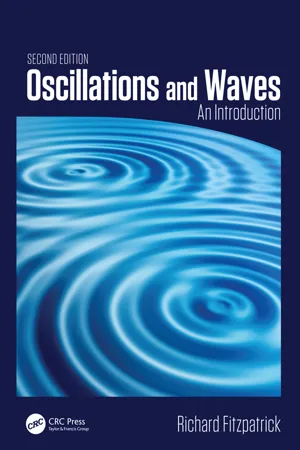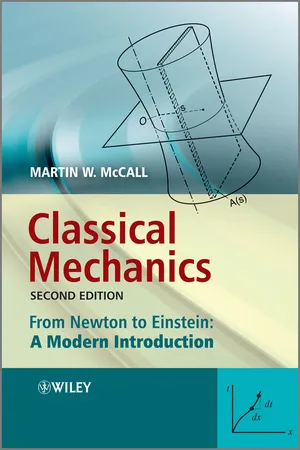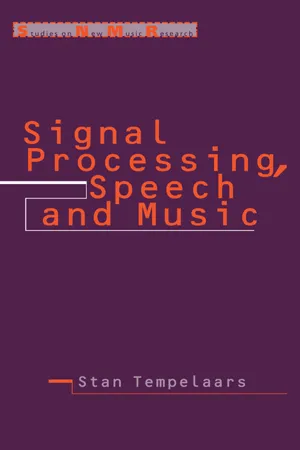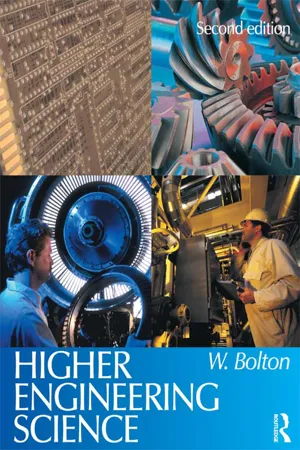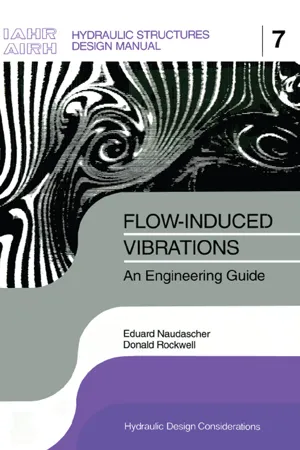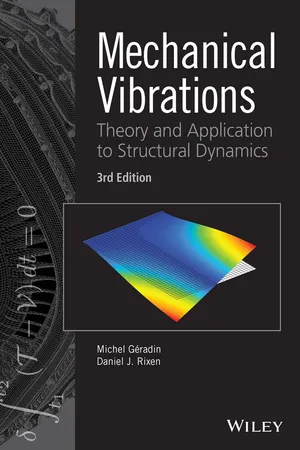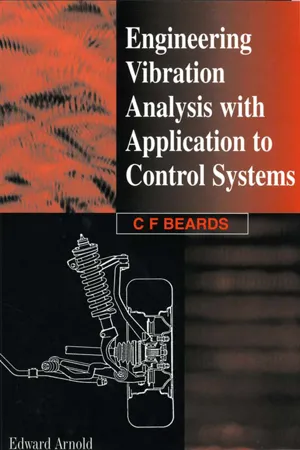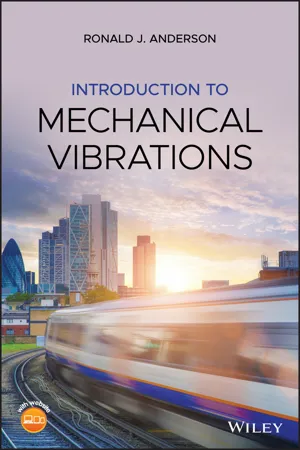Mathematics
Damped harmonic oscillator
A damped harmonic oscillator is a system that experiences a restoring force proportional to its displacement from equilibrium, as well as a damping force that reduces its velocity. This results in the oscillations of the system gradually decreasing in amplitude over time. The behavior of damped harmonic oscillators can be described using differential equations, and they are commonly encountered in physics and engineering.
Written by Perlego with AI-assistance
Related key terms
Related key terms
1 of 4
Related key terms
1 of 3
11 Key excerpts on "Damped harmonic oscillator"
- eBook - ePub
Oscillations and Waves
An Introduction, Second Edition
- Richard Fitzpatrick(Author)
- 2018(Publication Date)
- CRC Press(Publisher)
CHAPTER 2Damped and Driven Harmonic Oscillation
2.1 INTRODUCTIONIn the previous chapter, we encountered a number of energy conserving physical systems that exhibit simple harmonic oscillation about a stable equilibrium state. One of the main features of such oscillation is that, once excited, it never dies away. However, the majority of the oscillatory systems that we encounter in everyday life suffer some sort of irreversible energy loss while they are in motion, due, for instance, to frictional or viscous heat generation. We would therefore expect oscillations excited in such systems eventually to be damped away. The aim of this chapter is to examine so-called damped harmonic oscillation, and also to introduce the differential equation that governs such motion, which is known as the Damped harmonic oscillator equation. In addition, we shall examine the phenomenon of resonance in periodically driven, damped, oscillating systems. In this chapter, examples are again drawn from simple mechanical and electrical systems.2.2 DAMPED HARMONIC OSCILLATIONConsider the mass–spring system discussed in Section 1.2 . Suppose that, as it slides over the horizontal surface, the mass is subject to a frictional damping force that opposes its motion, and is directly proportional to its instantaneous velocity. It follows that the net force acting on the mass when its instantaneous displacement is x(t) takes the formf(2.1)(= − k x − m vx ,)x ˙x ˙,where m > 0 is the mass, k > 0 the spring force constant, and v > 0 a constant (with the dimensions of angular frequency) that parameterizes the strength of the damping. The time evolution equation of the system thus becomes [cf., Equation (1.2) ](2.2)x ¨+ vx ˙+ω 0 2x = 0 ,whereis the undamped oscillation frequency [cf., Equation (1.6) ]. We shall refer to the preceding equation as the Damped harmonic oscillator equationω 0=k / m - eBook - ePub
Classical Mechanics
From Newton to Einstein: A Modern Introduction
- Martin W. McCall(Author)
- 2011(Publication Date)
- Wiley(Publisher)
3 Oscillatory Motion 3.1 IntroductionAs we saw in the previous chapter whenever a system is disturbed from its equilibrium state then, providing the disturbance is not too large, the restoring force is always proportional to the displacement from equilibrium about which the system then oscillates. The situation is generic to all near-equilibrium systems and is worth studying in detail in this chapter as a special case of one-dimensional motion. First, we want to solve the equation of simple oscillatory motion in a mathematically rigorous fashion for which we will introduce a little theory about the differential equations we are trying to solve. Then we want to add some realism to the model by including damping, and then the possibility of an external periodic force. The latter problem will require new mathematical techniques, so we will solve it in two ways. First, by a geometrical method (rotating arrow) and then by a more powerful technique using complex numbers. The resulting solutions will predict many new effects that are pervasive in other areas of physics, the most notable being the phenomenon of resonance, whereby the amplitude of oscillations can increase dramatically when the frequency of the external force approaches the natural frequency of the system. Finally, we consider the situation when two oscillatory systems are brought together and allowed to interact, yielding coupled oscillations.It is worth stressing that all the situations considered in this chapter are models , exemplars of many oscillatory systems in physics. The analogue is exact for many electrical circuits wherein the ideas discussed find wide application. Even when the analogue is not perfect the results can still be effective – electrons in atoms are not really connected to the nuclei by springs, but a classical oscillator model provides a fair description.3.2 Prototype Harmonic OscillatorWe begin with what is essentially the problem analysed in Section 2.10 of the previous chapter. Consider the prototype oscillator model shown in Figure 3.1 . The mass, resting on a frictionless surface, is connected to a rigid support via a spring. When drawn to the right the distance from its equilibrium position is identified as x . Since it is not too far from equilibrium, the elastic limit is not exceeded and therefore the restoring force acting to the left is given by (−kx ), where k is the spring constant (units N m−1 = kg s−2 ). Applying Newton’s second law, the equation of motion ism+ kx =0 or, dividing through by the mass and defining ω 0 2 ≡ k/m, - eBook - ePub
- A. L. Stanford, J. M. Tanner(Authors)
- 2014(Publication Date)
- Academic Press(Publisher)
The mathematics necessary to treat these systems in detail, differential equations, is beyond the scope of this text. Nevertheless, physical descriptions of these systems are included here because they introduce two important concepts of physics that help us to understand—in an intuitive way, at least—some physical situations that are common to everyday experience. First, we shall describe damped oscillations, back-and-forth motions that lose energy as time passes, which correspond to actual oscillating systems. Then we shall consider forced oscillations, those driven by an external agent. These oscillators are considered in order to introduce resonance, a phenomenon seen in many physical systems. Damped Oscillations Oscillators that we can actually observe do not move forever with undiminished amplitude. Unless energy is supplied from a source outside the oscillator, it loses energy, and its amplitude decreases as time goes on. Swinging pendula, for example, eventually come to rest. A real mass oscillating on a spring finally comes to rest. How are these facts consistent with our descriptions of simple harmonic oscillators? Real oscillators are not, of course, the ideal models we have been analyzing. We have not accounted for the losses of energy that actual oscillators experience. To do so, it is necessary to recognize that damping forces—forces that reduce, or damp, the amplitude of oscillation—are present on actual oscillators. Damped oscillations, therefore, result from air resistance; from friction in various forms; or from dampers, devices that are designed expressly to reduce the amplitude of an oscillatory motion. In an ideal oscillatory system, the only force acting on the moving particle is the restoring force that is always directed toward the center of the oscillatory path. In oscillators that experience damping, an additional force acts on the particle in a direction that is opposite to the direction of the velocity of that particle at every instant - eBook - ePub
- Stan Tempelaars(Author)
- 2014(Publication Date)
- Routledge(Publisher)
HAPTER 3The Harmonic Oscillator 3.1 Undamped vibrations - the time-continuous caseA. The vibrating string; equation and solutionWe shall now study a few versions of the simple system called ‘the harmonic oscillator’. First we will analyse the behaviour of a vibrating string via a simplified model, in which we place a metal ball in the middle of the string. See fig.3.1.1 . Thanks to this ball we can ignore the mass of the string itself, which simplifies the calculation considerably. On the ball in both directions a force S is exercised by means of the tension of the string. We now assume now that during the vibration the displacement and therefore the changes in the length of the string are so small that we may consider S as a constant. We indicate the displacement of the ball with y(t). If the string at the place of the ball is pulled to the side the two forces S no longer lie in each others direction and a restoring force F occurs, which is shown in the diagram via the parallelogram construction and can be calculated as follows:If we combine this withFigure 3.1.1 Vibrating string.The factor 4S/L is abbreviated to b. In this expression both the magnitude and the direction of force F are represented, the latter with the minus sign that shows that the force and the displacement are in opposite directions. We combine this result with Newton’s law:This is a differential equation of the second order, which can be considered as the mathematical model of the system (see also Morse 1948). For the determination of the solution we start with a ‘trial’ function. This is a function that still contains several unknown coefficients, which we attempt to adjust in such a way that the function provides us with a solution for the equation. - eBook - ePub
- William Bolton(Author)
- 2012(Publication Date)
- Routledge(Publisher)
The total energy is thus constant at all displacements, depending only on the amplitude of the oscillation. What varies at different displacements is the fraction of the energy that is kinetic energy and the fraction that is potential energy. As an object oscillates there is a continual changing of potential energy to kinetic energy and vice versa with, in the absence of losses or inputs to the system, i.e. damping or forcing, the sum remaining constant.ExampleDetermine the energy of an object of mass 0.5 kg oscillating with simple harmonic motion of amplitude 100 mm and frequency 5 Hz.The angular frequency ω = 2πƒ= 2π × 5 = 31.4 rad/s. Thus, using equation [13 ]:energy = mω2 A2 = 0.5 × 31.42 × 0.12 = 4.93 JRevision5 An object of mass 0.1 kg oscillates with simple harmonic motion of frequency 15 Hz and amplitude 50 mm. Determine the total energy of the object.6.3 Undamped oscillationsThe following are derivations of the natural frequencies of a number of mechanical systems executing oscillations when damping is assumed to be negligible. The derivations are based on the technique of determining how the restoring force varies with displacement and then, provided the restoring force is proportional to the displacement and directed towards the rest position, using equation [9 ] to obtain the frequency.6.3.1 Mass on a springConsider a mass suspended from a vertical spring (Figure 6.6 ), the mass of the spring being assumed to be negligible. It is made to oscillate in the vertical direction by the mass being pulled down, so extending the spring, and then the mass is released. The spring then exerts a restoring force on the mass. Assuming that the spring obeys Hooke's law, then the restoring force F is proportional to the displacement x of the end of the spring from its rest position. The force is always directed towards the rest position and thus we can write:Figure 6.6 Mass on a springF = −kxwhere k is the spring stiffness. The motion is simple harmonic because F is proportional to −x. The magnitude of the force per unit displacement is k and thus, using equation [9 - eBook - ePub
The Duffing Equation
Nonlinear Oscillators and their Behaviour
- Ivana Kovacic, Michael J. Brennan(Authors)
- 2011(Publication Date)
- Wiley(Publisher)
Chapter 6 Forced harmonic vibration of a Duffing oscillator with different damping mechanisms Asok Kumar Mallik Department of Mechanical Engineering, Indian Institute of Technology Kanpur, India 6.1 IntroductionAs discussed in Chapter 2, the stiffness force in one form of a Duffing oscillator is expressed by a combination of a linear and a cubic nonlinear term. For small amplitude vibrations, this nonlinear term may be negligible compared to the linear term. The damping force, on the other hand, is assumed to be linear (viscous damping) only for mathematical simplification. Pippard [1] writes ‘There is something of a tendency among physicists to try to reduce everything to linearity …, reality may not conform to what we may wish, rather more so with the damping forces than with the restoring force in small amplitude vibration.’ In real life, the damping force, representing various dissipative mechanisms present in a system, may be a distinctly nonlinear function of velocity [2–5]. In some situations, a combination of linear and nonlinear terms may be necessary to model the damping satisfactorily. In this chapter, the response of a harmonically excited Duffing oscillator with different damping mechanisms is discussed.6.2 Classification of Nonlinear CharacteristicsNonlinear characteristics, present in both stiffness and damping forces, of the Duffing oscillator, are classified in this section. Some facts related to the stiffness force and the corresponding geometric nonlinearity shown in Chapter 2 and Chapter 3 are summarised and given here for the convenience of the reader. - eBook - ePub
Flow-induced Vibrations: an Engineering Guide
IAHR Hydraulic Structures Design Manuals 7
- Eduard Naudascher(Author)
- 2017(Publication Date)
- Routledge(Publisher)
f denotes the period of vibration.Figure 2.1. Definition sketch, (a) Simple undamped body oscillator, (b) Histogram of harmonic motion, (c) Vector respresenlation of harmonic motion. 2.2 FREE VIBRATIONThe simplest body oscillator consists of a discrete mass m free to vibrate in one direction (Figure 2.1a ). In the absence of damping and exciting forces, an initial displacement xowill produce free vibrations as shown in Figure 2.1b . They can be analyzed with the aid of the equation of motion or the energy method. In the equation of motion, the product of mass m and body acceleration d2 x/dt2 ≡ ẍ (the dots denote derivatives with respect to time) is set equal to the sum of all forcesmx ¨= ∑F x(2.3) which in case of a linear spring in the undamped system of Figure 2.1a is simply the restoring force, ΣFx= −Cx. The larger the spring constant C, the greater is the stiffness of the oscillator. The solution of the equation of motion
ismx ¨+ C x = 0(2.4)
withx =x ocos (ω nt − φ)(2.5) ω n= 2 πf n=C / m(2.6) where ωnis the natural circular frequency and fnis the natural frequency of the discrete-mass system. For the particular initial condition cited above, the phase angle φ is zero.For systems of greater complexity, determination of the natural frequency from the equation of motion becomes so complicated that it is advisable to use an energy approach. Since the spring force Cx is the only external force doing work on the system, the sum of elastic and kinetic energy is constant. Consequently, the kinetic energy mẋ2 /2 in the middle of the stroke (x = 0, ẋ = ωxo) must be equal to the elastic energy in an extreme position (x = xo, ẋ = 0), i.e.,
Figure 2.2. (a) Simple body oscillator with linear damping, (b, c) Histograms of responses for an underdamped (ζ < 1) and an overdamped (ζ ≥ 1) case.∫ ox oC x d x =1 2Cx o 2=1 2mω 2x o 2(2.7) - eBook - ePub
Mechanical Vibrations
Theory and Application to Structural Dynamics
- Michel Geradin, Daniel J. Rixen(Authors)
- 2014(Publication Date)
- Wiley(Publisher)
unless otherwise stated. It can thus be described by a dissipation function quadratic in velocities as introduced in Chapter 1, Section 1.3.3.Structural damping in itself is a huge subject which could not be covered in a single book chapter. The presentation will focus on the following aspects.In Section 3.1 the linear damping model will be described and its essential mathematical properties will be outlined. The classical assumption of modal damping which consists of neglecting the coupling of eigenmodes through damping will be introduced and its validity range discussed. A general method based on modal expansion to construct a proportional damping matrix matching experimentally measured modal damping ratios will be presented.Section 3.2 is devoted to the harmonic response of damped systems. The essential features of the response of the damped system in the frequency domain, together with its graphical representation (Nyquist plot, amplitude and phase diagram), will be recalled. The hysteretic damping model, which has the interesting property of keeping the linear character of the response in the frequency domain while fitting better the structural damping observed in practice, will be presented. Finally, the principles of force appropriation testing—a widely used modal testing method in the aeronautical community—will be described. The specificity of force appropriation testing is its ability to identify one by one the normal modes of vibration of the associated undamped system through cancelation of the damping forces by the excitation system.Section 3.3 addresses the case of linear systems subject to arbitrarily large viscous damping. The original dynamic model is cast in an equivalent first-order canonical form (the state-space representation) so that the formal analysis in terms of complex eigensolutions of the damped system can be defined. This more general formulation opens the way to experimental testing techniques that allow identifying the modal parameters (complex eigenfrequencies and eigenmodes) of the damped structural systems. - C. Beards(Author)
- 1995(Publication Date)
- Butterworth-Heinemann(Publisher)
M , assuming the soil acts similarly in tension and compression isThus the equation of motion becomes Motion is therefore simple harmonic, with frequency An alternative solution can be obtained by considering the energy in the system. In this case, andwhere the loss in potential energy of building weight is given by since for small values of θ. ThusAssuming simple harmonic motion, and putting T max = V max , givesas before. Note that for stable oscillation, ω > 0, so thatThat is ka 3 b > 12 mgh .This expression gives the minimum value of k , the soil stiffness, for stable oscillation of a particular building to occur. If k is less that 12 mgh/a 3 b the building will fall over when disturbed.2.2 FREE DAMPED VIBRATION
All real systems dissipate energy when they vibrate. The energy dissipated is often very small, so that an undamped analysis is sometimes realistic; but when the damping is significant its effect must be included in the analysis, particularly when the amplitude of vibration is required. Energy is dissipated by frictional effects, for example that occurring at the connection between elements, internal friction in deformed members, and windage. It is often difficult to model damping exactly because many mechanisms may be operating in a system. However, each type of damping can be analysed, and since in many dynamic systems one form of damping predominates, a reasonably accurate analysis is usually possible.The most common types of damping are viscous, dry friction and hysteretic. Hysteretic damping arises in structural elements due to hysteresis losses in the material. The type and amount of damping in a system has a large effect on the dynamic response levels.2.2.1 Vibration with viscous damping
Viscous damping- eBook - ePub
- Ronald J. Anderson(Author)
- 2020(Publication Date)
- Wiley(Publisher)
The equation of motion is (5.11) We need to look at all possible forms for a harmonic forcing function keeping in mind that we will need to find the particular solution for Equation 5.11. Note that we need to add together a function and its first two derivatives on the left‐hand side and make the sum equal to a single function on the right‐hand side. This is clearly a case where the complex exponential function is the best choice 1. Therefore, let (5.12) Before proceeding any farther, it is advisable to write the equation of motion in the standard form. We therefore divide Equation 5.11 by and write (5.13) Figure 5.4 Damped SDOF system with a harmonically applied force. and assume that the steady state solution for is (5.14) with derivatives (5.15) and (5.16) Substituting into Equation 5.13 gives (5.17) from which we can solve directly for which, after a little rearranging of terms, becomes (5.18) Admittedly, in Equation 5.18 is a complex number, but that simply indicates that the response can be written as an amplitude and a phase angle. Before working out the amplitude and phase angle we will manipulate Equation 5.18 in order to make it dimensionless. We start by dividing the numerator and denominator by to get (5.19) Then we note that the term,, in the numerator is simply equal to so that the numerator becomes which is the static deflection that we found in Equation 5.7. We can then write (5.20) This is a good time for a short review of complex numbers. Any complex number, can be represented by a magnitude and a phase angle. If you plot as a point on the complex plane you will see that you can represent the same point in polar coordinates with a line of length that lies at an angle from the real axis where. The number can equally well be represented as a complex exponential using Euler's Identity. That is, we can write For what we are about to do, the exponential notation is preferable - eBook - ePub
Structural Dynamics of Earthquake Engineering
Theory and Application Using Mathematica and Matlab
- S Rajasekaran(Author)
- 2009(Publication Date)
- Woodhead Publishing(Publisher)
4 Forced vibration (harmonic force) of single-degree-of-freedom systems in relation to structural dynamics during earthquakes Abstract In this chapter, forced vibration of single-degree-of-freedom (SDOF) systems (both undamped and under-damped) due to harmonic force is considered. Governing equations are derived and the displacement response is determined using Wilson’s recurrence formula. Vibration excitation due to imbalance in rotating machines is discussed. Equations for transmissibility are derived for force and displacement isolation. The underlying principle of vibration-measuring instruments is illustrated. Key words resonance transient steady state magnification factor beating transmissibility seismometer accelerometer 4.1 Forced vibration without damping In many important vibration problems encountered in engineering work, the exciting force is applied periodically during the motion. These are called forced vibrations. The most common periodic force is a harmonic force of time such as P = P 0 sin ω t 4.1 where P 0 is a constant, ω is the forcing frequency and t is the time. The motion is analysed using Fig. 4.1. m x ¨ + kx = P 0 sin ωt 4.2 4.1 Spring-mass system subjected to harmonic force. The general solution of Eq. 4.2 (non-homogeneous second order differential equation) consists of two parts x = x c + x p where x c = complementary solution, and x p = particular solution. The complementary solution is obtained by setting right hand side as zero. m x ¨ c + k x c = 0 4.3 x c = c 1 sin ω n t + c 2 cos ω n t 4.4 where ω n = k / m and c 1 and c 2 are arbitrary constants. Assume x p = A sin wt and. substituting m x ¨ p + k x p = P 0 sin ωt 4.5 − ω 2 mA + kA sin ωt = P 0 sin ωt 4.6 A = P 0 k 1 − ω 2 m / k = P 0 k 1 − ω 2 / ω n 2 4.7 Since β = ω / ω n, A = P 0 k 1 − β 2 = P 0 / k 1 − β 2 4.8 If[
Index pages curate the most relevant extracts from our library of academic textbooks. They’ve been created using an in-house natural language model (NLM), each adding context and meaning to key research topics.
Explore more topic indexes
Explore more topic indexes
1 of 6
Explore more topic indexes
1 of 4
